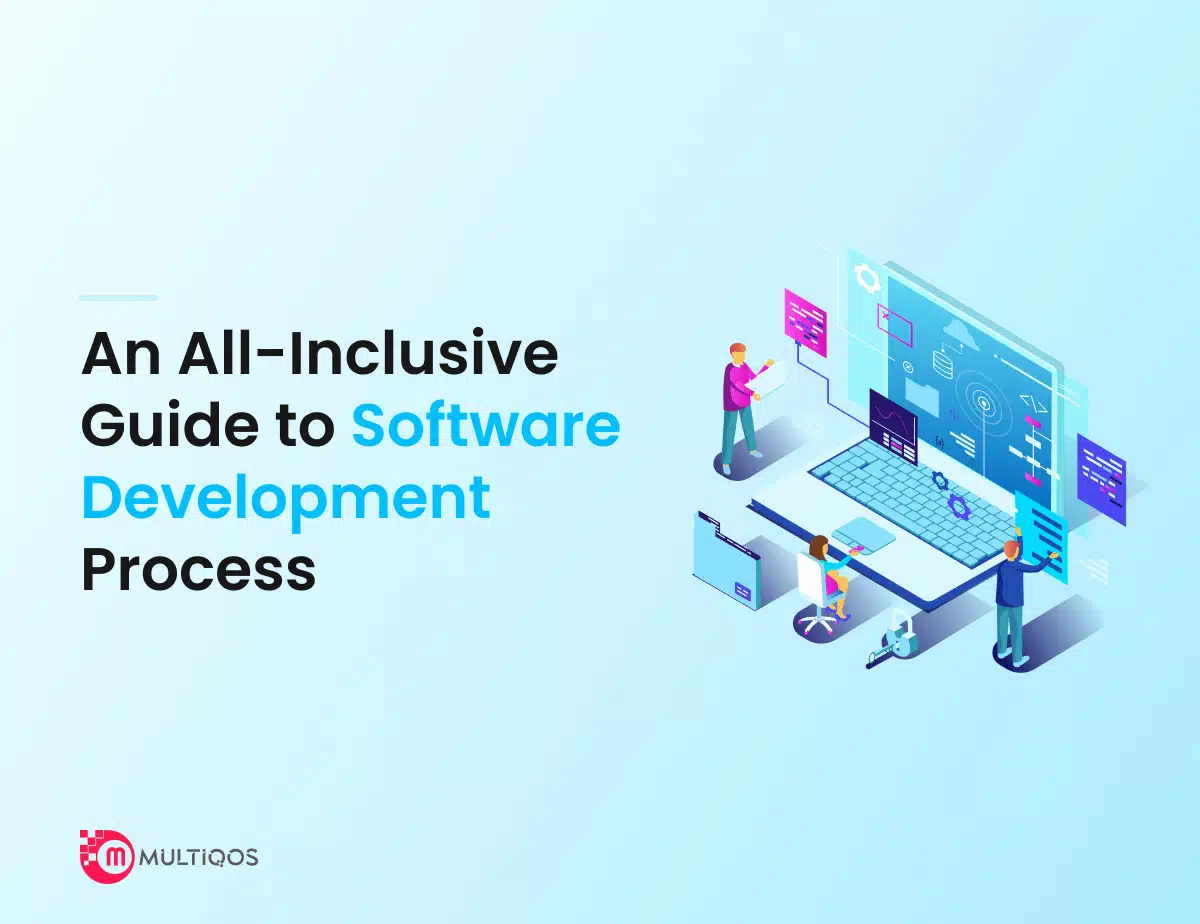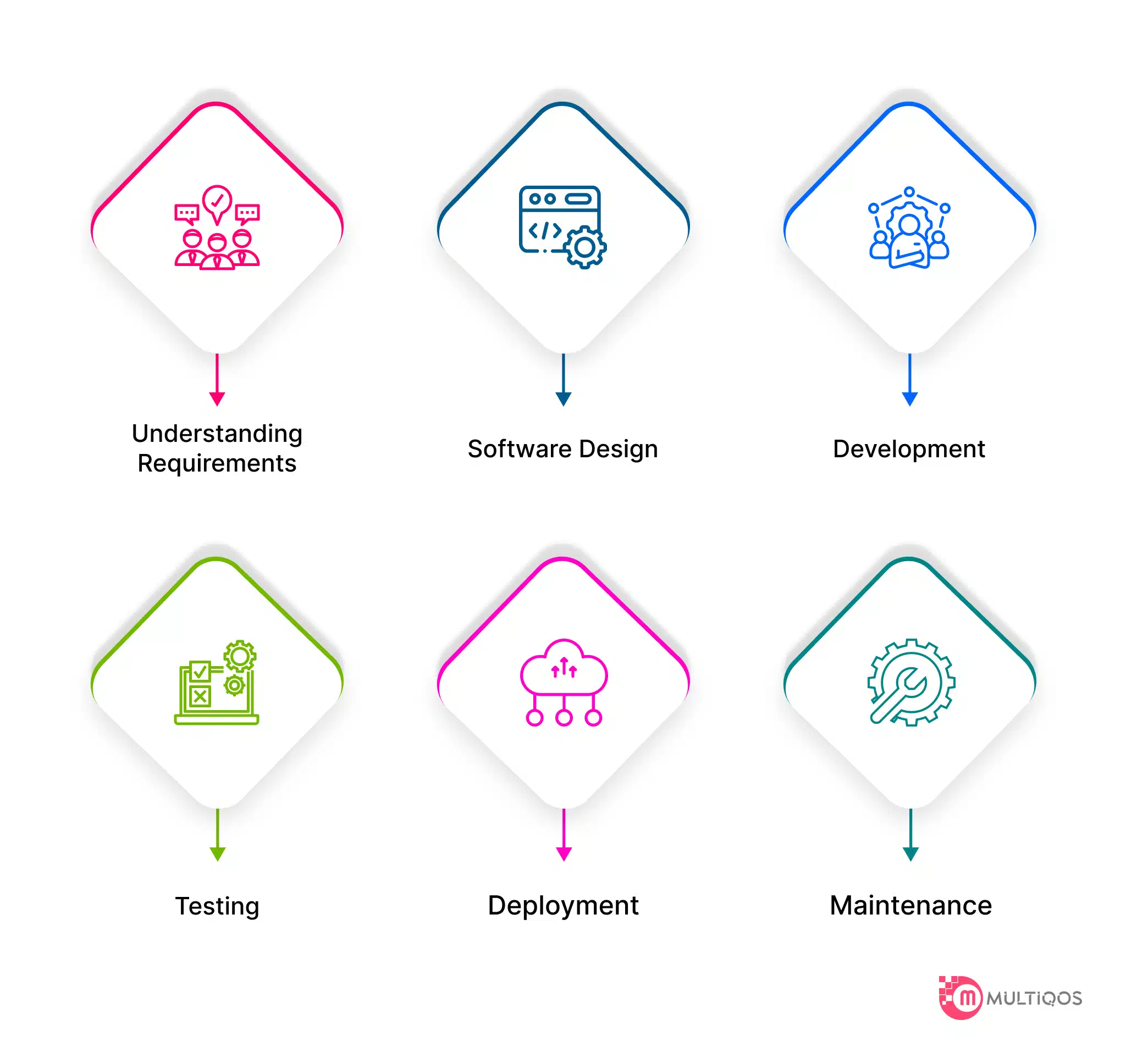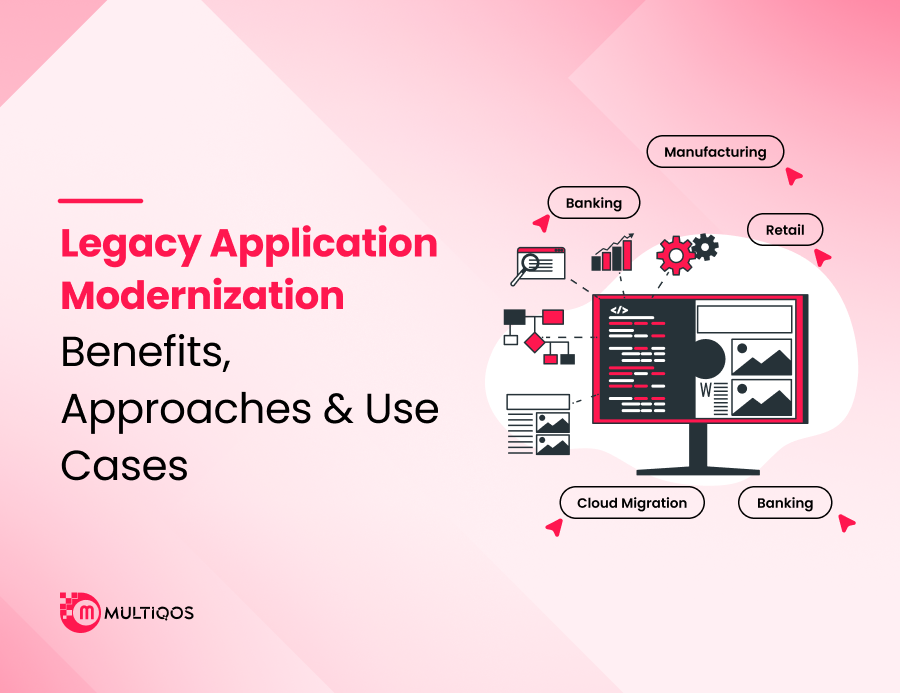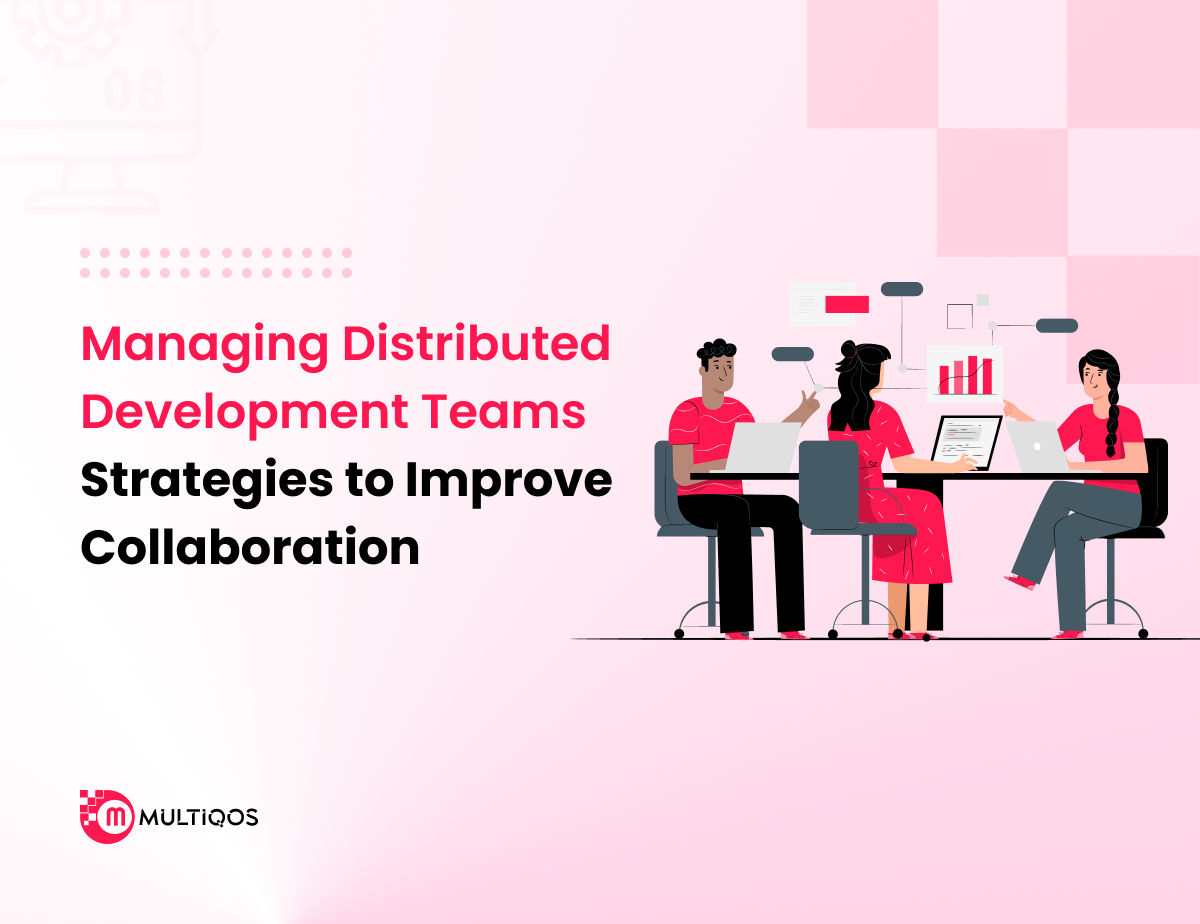An All-Inclusive Guide to Software Development Process

Table of Contents:
Software development is complex and needs proper planning and skilled resources to make it a success. Plus, choosing the right development methodology is necessary to streamline the process, minimize human errors, and maximize the ROI.
So, software development methodology is pivotal for developing and delivering successful software applications. It defines a clear roadmap for software development and provides a structural framework for it.
Keep reading to understand everything about software development, its types, benefits, and a lot more information.
What is a Software Development Process?
The Software Development Process is an organized way to create software products. It involves well-defined steps to complete a software development project from ideation to deployment. The objective of this process is to develop software methodically to ensure that it meets the necessary quality metrics, standards, and clients’ expectations.
The Software Development Process is also referred to as Software Development Lifecycle or SDLC. It provides a structured way to turn abstract ideas into interactive and dynamic software solutions. It also defines different responsibilities, divides the work, and streamlines the development process. Companies utilize various SDLCs to get the best outcomes for software development.
There are various steps involved in a typical software development process as given below:
- Understand the objective of software and plan its development.
- Software design to define how it will look and how it will work.
- Perform stringent testing to make sure it functions as expected.
- Deploy software in the production environment to make it available to users.
- Perform continuous maintenance to ensure seamless functionality.
What are the Benefits of the Software Development Process?
The following are the key benefits of a software development process.
Enhanced Quality
Since a software development process provides a coherent and well-defined procedure to develop software, the final output is likely to be of greater quality than developed otherwise. The process provides a structured way to complete software development with clearly defined steps, roles, and responsibilities.
By breaking down the entire process into manageable chunks known as stages, developers and other team members working on the project can coordinate efficiently minimizing errors. Consequently, the end product is likely of the best quality.
Better Collaboration
Different teams know their roles and responsibilities when they work according to a software development process. It leads to better communication among teams and prevents miscommunication which is pivotal for the successful completion of software projects.
SDLCs like Waterfall allow teams to work step by step which means the project moves to the next step only when the previous one has been completed. Thus, it eliminates the chances of human errors and other mistakes that could impact the project’s progress.
Efficient Resource Utilization
A well-planned software development process not only helps in developing software strategically and systematically but also ensures optimal use of resources. With an SDLC, project managers can efficiently allocate resources and define their responsibilities precisely to ensure optimal use of them. Consequently, the right people are working on the task.
It will help accomplish the project with expected outcomes within the defined timeframe. The even distribution of resources and assignment of tasks to the correct people will ensure a smooth workflow with the lowest turnaround time.
Effective Risk Management
As per a report, unplanned project initiation, technical challenges, and lack of resources are the primary reasons behind 70% of failed projects. Moreover, a software development process can help mitigate such risks by providing a structured and strategic approach to developing software.
With proper planning and research, the SDLC helps businesses get insights into the potential risks and enables them to take proactive measures to minimize the chances of such risks. Hence, SDLC is essential to manage and minimize risks.
Ensures Consistency and Accuracy
Software development teams can work consistently and accurately with an SDLC. Consistency is maintaining the right standards across different phases. The software development lifecycle ensures consistency by allowing teams to work as per defined rules and guidelines.
A software development process enables development teams to understand their roles and provides a roadmap to work in symphony. Hence, the team can work with consistency and accuracy to ensure project delivery on time and with the best quality.
Steps of the Software Development Process
A typical software development process is divided into multiple stages that involve various tasks. This division helps streamline the development process and minimize human errors. Let’s see the different steps in a typical software development process.
Understanding Requirements
This step is also known as requirement gathering and requirement analysis. Requirement analysis helps capture essential information about the software development project to come up with an efficient plan to build software.
In this step, the project managers gather information about functional and non-functional requirements. Plus, you need to identify if the software you plan to build aligns with the business goals of the client.
Software Design
Once the planning and analysis are over, the next step is to design software to define its components, UI, and functions. Prototyping helps create a basic functional model of the software product for demonstration purposes.
In this phase, software architecture is created that defines the interactions between different components. You need to explain what you want from the software to allow designers to create the perfect model.
Designers use various tools like Figma, InVision, Illustrator, and more to create software designs. It is an important solution that developers will use to create the desired software solution.
Development
The next phase of the software development process is development. This is the stage where designs are turned into actual products. With all the requirements in hand and the design, software developers take charge and code software as per specifications.
The software development team crafts various functions and components using pre-determined tools and technologies. You may have already chosen the type of technologies you want to work with to create your software.
Developers can work with programming languages like PHP, Python, JavaScript, Java, etc. Alternatively, they can leverage frameworks like Django, Angular, React, ASP.NET, Spring, etc. There is a wide range of technologies used for developing software and it depends on the tech stack finalized in the requirements phase.
The developers will create the front-end and back-end of a web application with the desired technologies. They will also integrate third-party components.
Testing
The testing phase begins after development. The QA (Quality Assurance) team will perform rigorous testing to identify and resolve any bugs or errors that could impact the behavior of software. QA engineers perform various tests to check software functionality, performance, security, and other aspects.
Deployment
When the testing is completed and the software passes all these tests, it is pushed to the production environment. It means it is deployed on the platform from where it is available publicly to the end users. The deployment platform could be on-premises or in the cloud like AWS, Azure, or Google Cloud Platform.
Maintenance
Although software is deployed till this phase, it is not yet over. Maintenance is also a crucial part of the process. In this phase, continuous monitoring and analysis are done to ensure that it runs smoothly and functions as expected.
Top Software Development Methodologies
Waterfall
Waterfall is a traditional software development methodology that is still relevant and used by businesses to develop software. In this methodology, the entire software development lifecycle is divided into sequential phases.
Hence, there are many distinct phases to developing software solutions. Further, each of these phases depends on the other. It means the next phase starts when the previous one finishes.
Key benefits of Waterfall SDLC include:
- Clear and well-defined structure.
- Easy to understand.
- Quite useful for small-scale projects.
- The end goal of the project is defined upfront.
- Information is transferred well.
- Provides a disciplined workflow.
- Milestones and deadlines are clearly defined.
Agile
Agile is a trending software development methodology that is widely used to build software solutions. It is an iterative approach and the whole project is completed in sprints that are tasks divided as per short timeframes.
As a flexible software development methodology, Agile is suitable for projects where changes are frequent. Development teams can adjust their strategies after every sprint.
Key benefits of Agile SDLC include:
- It improves project schedules and predictability.
- It helps enhance customer satisfaction.
- Better cross-functional collaboration.
- Teams can make changes quickly and easily with better flexibility.
- Enhanced communication improves decision-making.
- Better risk management and product quality.
Spiral
Spiral is among the most popular software development methodologies. It is a combination of iterative and waterfall software development methodologies. It offers an iterative and systematic approach to developing software.
In graphical representation, it looks like a Spiral with several loops thus driving its name. The number of loops in this model are cannot defined upfront because they vary from one project to another. Each loop is a phase in this SDLC.
Key benefits of Spiral SLDC include:
- Changes and additions can be made at any stage of the process.
- The early identification of risks helps avoid project overruns and failures.
- The Spiral model helps developers ensure that the outcome aligns with customer expectations.
- Every build is completed on the previous learnings with each cycle.
- Project estimates are realistic with its progress.
V-Model
V-Model is an augmented methodology of Waterfall with sequenced steps. However, there is a corresponding testing phase for each phase of software development in V-Model. As a result, errors and issues can be found at every phase of developing software. It eliminates the chances of defects that could affect the performance and quality of software.
Key benefits of V-Model SDLC include:
- V-Model is a simple and easy-to-use approach.
- Potential flaws are discovered at every stage of the development process.
- Testing takes place along with the SDLC progress.
- With an advanced development approach with V-Model, there is an upward bend during testing phases to ensure the functions and features of the software work smoothly.
- It is effective for small projects where the details are well-defined upfront.
Lean
Lean is a software development process that focuses on minimizing the waste. It means it is designed in a way that delivers value to customers while minimizing the waste of resources. In this process, software is designed and developed with the essential features required for users.
It is a systematic approach to enhancing processes and optimizing resources. Lean methodology depends on two pillars: respect for people and continuous improvement. It emphasizes on discovering and eliminating those things that cannot create value for customers.
Key benefits of Lean methodology include:
- Rapid iteration and feedback loops ensure faster development.
- It focuses on the quality of software with its customer-oriented approach.
- Lean methodology offers faster speed in development and delivery.
- Team ownership and empowerment are a literal part of it.
Final Thought
After going through plenty of information about the software development process, you must be in a better position to understand its importance. Without proper planning and guidance, any project can go awry which could lead to failure.
Similarly, software development can go on the wrong track when not properly planned. This is why the software development process is essential. It ensures proper coordination among teams, well-defined steps, and streamlined tasks.
If it seems challenging for you, outsourcing your software development project is the best option. A reliable software development company like MultiQoS can help you achieve your goals with the right resources and processes.
Get in touch with us to understand our software development process and learn how we can help you fulfill your digital ambitions.
FAQ on Software Development Process
SDLC or Software Development Lifecycle defines the steps to build, test, and deploy software. It provides a structured method to develop software. Today, teams use lots of SDLCs to plan and execute software development projects.
Popular SDLCs include Waterfall, Agile, Scrum, Spiral, V-Model, etc. SDLCs make project management easy and streamline the development process. It defines different stages in which software is developed and each stage has distinct tasks.
A typical software development process begins with the ideation phase where proper research is done to define the project scope and prepare the roadmap to accomplish the project. Once the research part is done. The next step involves creating prototypes or mockups to replicate software behavior and test the feasibility.
After completing this step, the next step includes UI/UX design. Next, the project moves to the development phase where developers will code the business logic and other parts of software. When the development is completed, rigorous testing is done to find bugs and flaws to ensure the best quality of software. The final step involves delivering and deploying the software.
Actually, it depends on the type of software and several other factors. Software development outsourcing offers many excellent benefits that help you save valuable time. While building an in-house team for software development, you have to spend on salaries, office rent, electricity bills, insurance covers, and dozens of other expenses.
However, outsourcing can eliminate these costs and provide a quick solution to needs. You can choose a reliable software development company to outsource your project and develop top-notch solutions for your business. You only care about project management in outsourcing.
All the headaches of development, testing, and deployment of software are put on the outsourcing partner’s shoulders. Plus, they will guide you and help to develop the right solution with their expertise and experience.
Requirement gathering is a crucial step in software development that involves collecting key details about the functional and non-functional requirements of your project. It helps define a clear roadmap for the project and the objectives.
Software development teams can work accordingly and create the right solution that aligns with the client’s expectations and users’ needs. It helps project managers understand what product to develop and why to put the right resources and development approach.
Get In Touch







